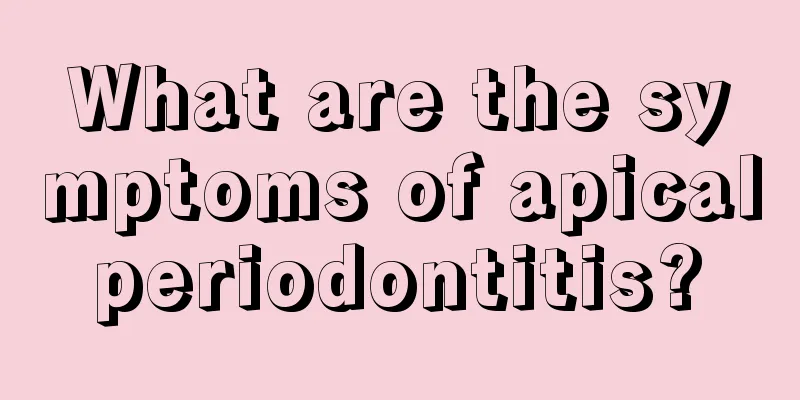What are the symptoms of apical periodontitis?

|
Teeth are very important chewing tools. Without teeth for basic processing of food, it will be difficult for people's stomach and intestines to digest food. Therefore, teeth reduce a large burden on the stomach and intestines. Although teeth are components of bones, they are also prone to pathological reactions. For example, the tissue of the tooth root is very susceptible to inflammation. Let's take a look at the manifestations of apical periodontitis. Acute or chronic inflammation of the tissues around the root apex is called apical periodontitis. When pulpitis develops to the late stage and most or all of the pulp tissue is necrotic, or there is bacterial infection, it causes inflammation of the periapical tissues. When the tooth is hit by a sudden external force, the periapical tissues are also severely traumatized and cause apical periodontitis. Medical-induced infection during treatment can also cause apical periodontitis. Clinical manifestations 1. Acute apical periodontitis In the early stage, the affected tooth will have mild pain. At this time, the pain can be temporarily relieved by clenching the affected tooth. As the inflammation worsens, the patient's teeth will elongate and light tapping of the affected tooth will cause pain. In apical periodontitis, the pain is spontaneous, persistent, and localized, and the patient can clearly point out the affected tooth. If the acute apical periodontitis continues to develop and forms an acute apical abscess, the pain will intensify, the percussion pain will be obvious, and there will be persistent throbbing pain. The pus spreads to the subperiosteum, and the pain and swelling are obvious. Once the pus penetrates the periosteum and reaches the submucosal area, the pain is relieved than before. 2. Chronic apical periodontitis (1) There is generally no spontaneous pain in periapical granulomas. The patient only feels discomfort when chewing, weakness when biting, a strange sensation when percussed, and a feeling of elongation of the affected tooth. At this time, the pulp is mostly necrotic, and acute attacks may occur when the body's resistance is low. (2) There are usually no symptoms of periapical abscess. There may be fistulas in the mucosa of the periapical area of the affected tooth. Granulation tissue often proliferates at the opening of the fistulas, and pus may be discharged from the fistulas. However, due to the drainage of the fistulas, it is not easy to turn into acute inflammation. (3) There are usually no subjective symptoms of apical cysts. The teeth will change color. Dental radiographs can show the cyst at the apex. If the cyst increases in size, it will force the surrounding bone to be absorbed. The mucosa at the apex of the affected tooth will often appear as a semicircular bulge, resembling a ping-pong ball. |
<<: You must know the eight dangers of high blood lipids!
>>: What are the symptoms of mucositis?
Recommend
Can banana and watermelon be eaten together
Nowadays, many people pay great attention to nutr...
What is the reason for having a fever and feeling cold? What are the correct ways to reduce fever?
Many people usually feel chills due to high fever...
What are the characteristics of rotavirus enteritis
Rotavirus enteritis is a relatively common and pa...
Can mung beans still be eaten after being stored for three years?
Summer is the season for eating mung beans, mainl...
Chicken gizzard skin is so effective in treating gallstones
Chicken gizzard skin actually refers to chicken g...
What are the early symptoms of ovarian cancer
What are the early symptoms of ovarian cancer? 1....
Erythropoietin is high
We all know that every indicator of the human bod...
What is xanthelasma?
Xanthelasma is actually a yellow patch formed on ...
How to perform breast cancer surgery
Breast cancer surgery is performed according to n...
How to clean a pillow core
In fact, everyone knows that if the pillow core i...
How to effectively regulate Qi deficiency and blood heat
People with blood deficiency and blood heat must ...
What diseases can be checked by black MRI
MRI is a very advanced imaging diagnostic device ...
What are the symptoms of compression of nerves in the neck
The main cause of cervical spondylosis is the com...
Medical treatments for cardiac cancer
Cancer can also occur in the gastrointestinal tra...
There is a lot of dandruff
There is too much dandruff on the head. If you do...









